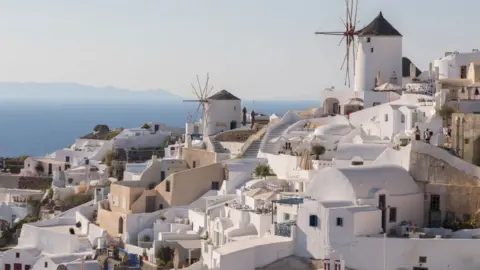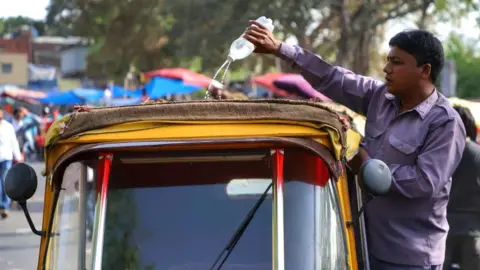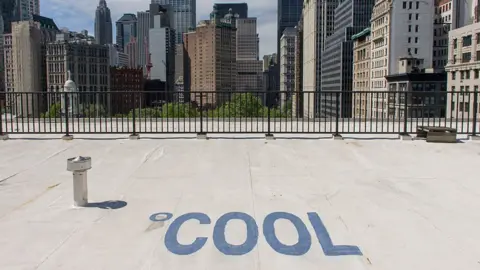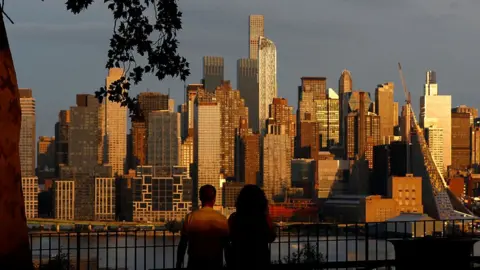How much can painting a roof white reduce its temperature?
 Getty Images
Getty ImagesIt has long been known that painting the roof of a building white reflects sunlight and reduces its temperature.
But by how much and are there downsides to doing it?
In a recent BBC interview, the former UN Secretary General Ban Ki-moon suggested that this reduction could be as much as 30C, with the internal temperature of the building falling by as much as seven degrees.

So where do these figures come from and does wider research back this up?
Mr Ban was talking about a pilot project in Ahmedabad City in western India, where summer temperatures can reach as high as 50C.
In 2017, more than 3,000 city rooftops were painted using both white lime and a special reflective coating.
Known simply as "cool roofing", this process is designed to reduce the solar radiation absorbed, which in turn means less heat is transferred inside the building.
Cool roofs also emit away some heat normally retained by a building, cooling it further.
 Getty Images
Getty ImagesThe planning document for the Gujarat project states that reflective roof coverings "can help bring roof temperatures down by as much as 30C and reduce indoor temperatures by three to seven degrees".
But this is not an actual finding from the project itself.
"Depending on the setting, cool roofs can help keep indoor temperatures lower by 2C to 5C as compared to traditional roofs," says Anjali Jaiswal, of the US-based Natural Resources Defence Council, which oversaw the Ahmedabad project.
This range is slightly lower than Mr Ban's figure for the reduction of building temperatures, but is still a significant drop.
Another pilot in Hyderabad in southern India, using a cool roof coating membrane, found indoor air temperatures lower by an average of 2C.
As for Mr Ban's claim of a 30 degree fall in the temperature of the rooftop itself, the Gujarat pilot does not provide answers, but we can turn to the findings of a study by the California-based Berkeley Lab for some guidance.
It found that a clean white roof that reflects 80% of sunlight will stay about 31C cooler on a summer afternoon.
The conditions would of course be very different in California to those found in India - where more than 60% of roofs are made from metal, asbestos and concrete, which trap heat inside buildings even when treated with white coating.
However, both Indian cities, Ahmedabad and Hyderabad, have seen sufficient success with their pilots that they have launched expanded cool roofs programmes this year.
 Getty Images
Getty ImagesSo why aren't more cities being painting white?
The idea is of course not new, and white roofs and walls have been a typical sight for centuries in southern European and North African countries.
The city of New York has recently coated more than 10 million sq ft of rooftops white.
Other places like California have updated building codes to promote cool roofs, which are seen as an important way to save energy.
A cool roof can save air-conditioning costs by as much as 40%.
An experiment in Bhopal in central India found that solar reflective paint on low-rise buildings saved energy load by 303 kWh in peak summer hours.
There are even estimates for the potential reduction in global carbon emissions if cooling paint was used on rooftops in every large city around the world.
The Berkeley Lab says the worldwide use of reflective roofing could produce a global cooling effect equivalent to offsetting 24 gigatonnes of carbon dioxide - the equivalent of taking 300 million cars off the road for 20 years.
 Getty Images
Getty ImagesIt is certainly a low-cost option, particularly in poorer countries.
A coating of lime wash "can cost as little as 1.5 rupees (£0.017; $0.02) per sq ft to more expensive reflective coatings or membranes", says Ms Jaiswal.
The differences can be considerable both in personal comfort and in energy savings on cooling.
Ultimately, however, "political will and implementation play a big role", says Ms Jaiswal.
And there are possible downsides to consider.
For cities with colder winters, reflective roofs might increase demand for heating and roof condensation is a mould risk.
This is why a University College London team decided not to use white paint for a resettlement colony project in New Delhi.
"The residents were also against painting roofs white, because roofs are also used for other purposes," says Renu Khosla, from the Delhi-based Centre for Urban and Regional Excellence.
The highly reflective paint, she says, makes it hard to go out on to the roofs to use the space for storage and daily household chores.
A team from the University of Chicago also carried out research in the same area near Delhi.
They painted the roofs of a group of buildings and found that even though indoor temperatures fell by only modest amounts, those living in them did adjust their behaviour to save money on energy bills and water use.



